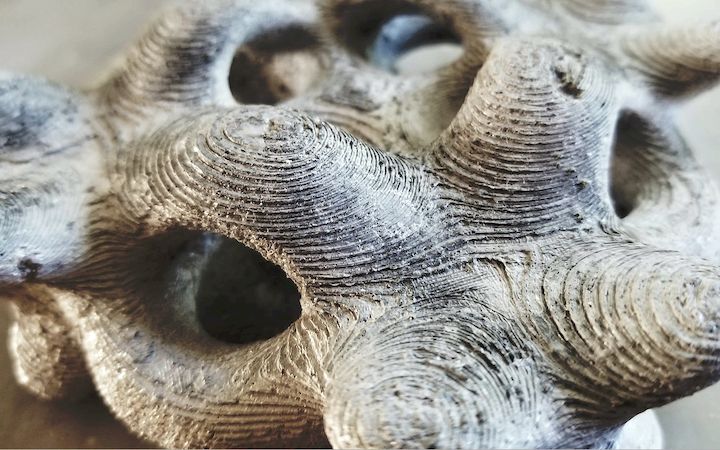![A very complex concrete object cast with two different soluble support materials [Source: Jacob Blitzer]](https://fabbaloo.com/wp-content/uploads/2020/05/alternately-soluble_img_5eb097b81854d.jpg)
I’m reading about a very unusual technique for 3D printed casting that involves two soluble support materials.
This process seems to have been pioneered by Jacob Blitzer, who was inspired to investigate this technique by an old post by ZMorph, makers of a multi-tool 3D printer. Their approach was quite interesting: they 3D printed a mould in soluble support material.
Normally soluble material is used only for support structures. It holds up the “actual” model during printing, and then silently dissolves away in fluid after printing, while the 3D printer operator pursues other matters.
In ZMorph’s case, the object they 3D printed was entirely soluble material. But the trick was that the object was itself a mould. Into this mould they poured a Metal Fluid, which is a metal-infused liquid resin. It hardens after casting.
Then they simply dropped the entire block into water (in this case, as their soluble material was PVA), causing the PVA to dissolve, leaving the cast object.
It’s a brilliant solution.
But Blitzer realized there was a problem. This approach works very well on a simple geometry object, but things get a lot more interesting on other more complex objects. Blizter explains:
“Unfortunately the technique is deceptively limited, as I found when attempting to replicate it.
The fundamental problem with unsupported moulds is the geometric complexity that is introduced when you go from printing the model itself, a positive, to printing a negative ‘shell.’
Printing and removing supports, even for a moderately complex model like Benchy, is relatively straightforward. But removing supports for the shelled version of this part is virtually impossible with single material supports.
In most cases, this is a job for soluble support material. But if your build material (grey) is itself soluble, it appears that you’re out of luck. That is, unless you have two dissolvable support materials, each soluble in a different solvent. This Alternately Soluble strategy is what I have pursued for the last few months: I used two soluble materials to create a fully supported and dissolvable mould.”
![A complex mould is required to cast a #3DBenchy in concrete [Source: Jacob Blitzer]](https://fabbaloo.com/wp-content/uploads/2020/05/image-asset_img_5eb097b8661a8.jpg)
In other words, the mould is so complex that it itself requires support structures. But since they require dissolving at different stages, you need two different soluble materials that use different solvents.
Do such materials exist? Yes, indeed. HIPS, for example, is dissolvable in limonene, not water. Meanwhile, PVA is dissolvable in water. There’s one combination that might be considered for this process. However, Blitzer correctly realized that the thermal conditions for the two materials should be close, otherwise 3D printing might fail.
He ended up using Hydrofil, a water-soluble support material provided by Airwolf 3D. This, Blitzer found, was relatively easy to use in this unusual process.
![Complex concrete objects cast with two different soluble support materials [Source: Jacob Blitzer]](https://fabbaloo.com/wp-content/uploads/2020/05/alternately-soluble-concrete-casts_img_5eb097b8b100c.jpg)
Did it work? Blitzer succeeded in casting concrete into a dual-soluble 3D printed mould as you can see at top.
Blitzer’s post reveals all the details of his rather involved experiment, including the techniques he used to design and execute the creation of these complex concrete casts. I encourage you to read through his experience.
Thinking about this experiment suggests there may be future applications for the process. I am wondering whether this could be practically applied in the architectural domain, where complex concrete structures would likely be a desirable capability. Currently such structures are limited by standard moulding constraints, but Blitzer’s process smashes through that barrier.
One of the challenges encountered by Blitzer was the difficulty in pouring in the rather coarse and viscous concrete mixture through the small entry holes created on his desktop 3D printer. I’m thinking that architectural pieces would likely be quite a bit larger and thus have larger openings, making the process more executable.
But a big concern I would have regarding scaling up this process (we should have a good name for it, by the way — Blitzer calls it “Alternately Soluble”), is the cost of the soluble materials required. Currently the cost of PVA, for example, is around US$80/kg. That could make for a very expensive mould print at large scales. It would also require printing on a large-format device, but those certainly exist.
I believe this is a 3D printing business opportunity that should be investigated to determine financial and technical feasibility. Who knows, perhaps it might be the next boom area in 3D printing?
Via Jacob Blitzer











